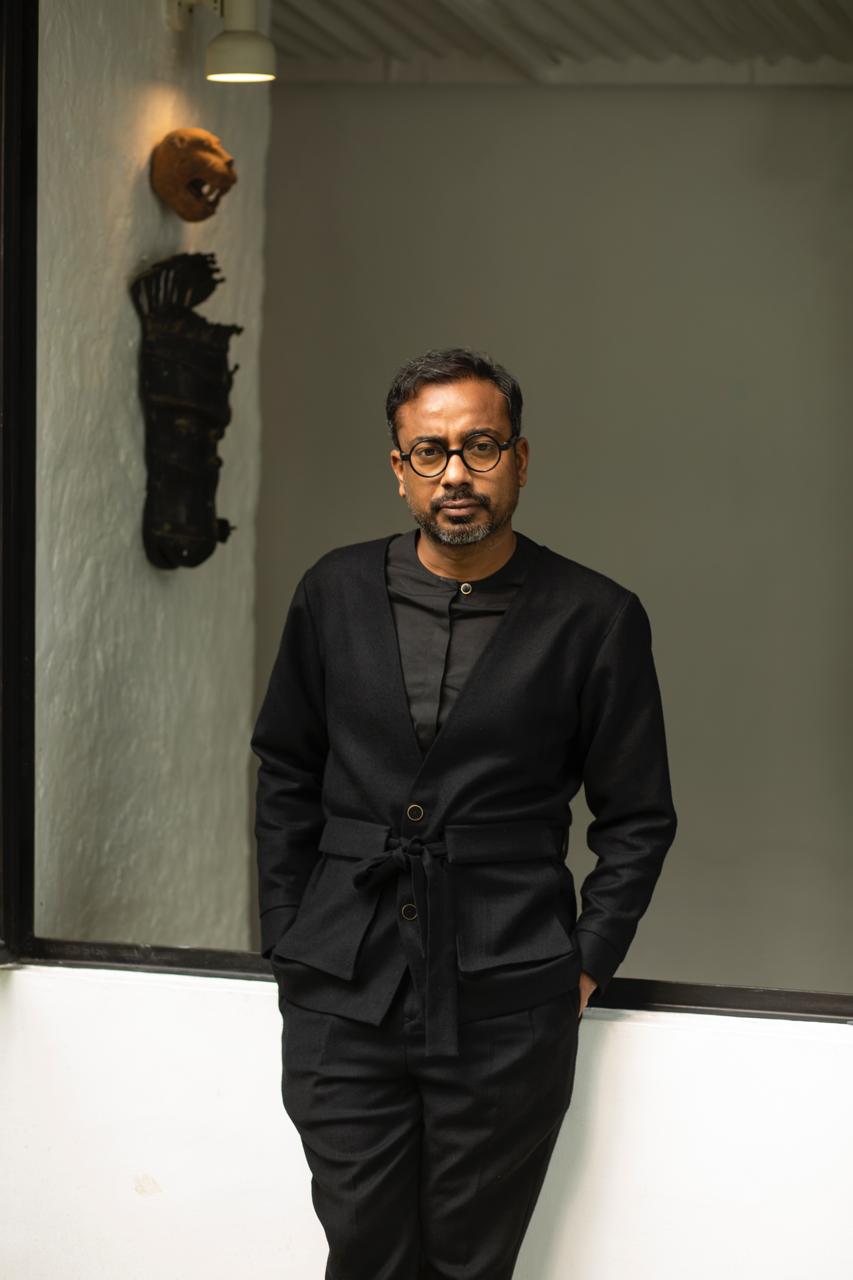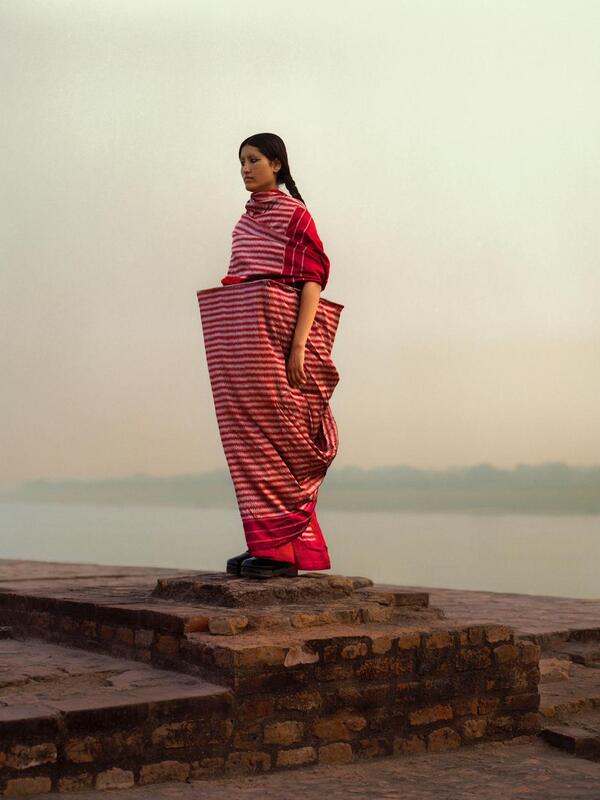(April 28, 2025) Sanjay Garg’s love affair with ‘saree’ is ever lasting. It’s real, intense and one of a kind. Sari — a symbol of grace and tradition not only in India but world over — brings out the best in Sanjay, allowing him to style it in numerous ways. The end result is a treat for the eyes. “Sari is versatile, it’s elegant and a powerful garment,” sums up Sanjay Garg, the renowned fashion innovator and founder of the iconic brand Raw Mango, in a chat with Global Indian.
Sanjay has been instrumental in reviving textile-based practices in India and reinventing the sari. His work was recently celebrated in The Offbeat Sari, an exhibition at the Design Museum in London that showcases the sari’s rise as a global fashion statement.
Offbeat Sari: Showcasing the Sari’s Global Evolution
“The Offbeat Sari is the first contemporary exhibition to focus on the sari. It celebrates the garment as a global fashion icon, showcasing its enduring versatility and cultural relevance,” says Sanjay, whose appreciation for aesthetics began with the sensibilities of rural India.

Sanjay Garg, founder of Raw Mango
The touring exhibition was curated by Priya Khanchandani, the head of curatorial and interpretation at the Design Museum, London. “The exhibition examines the evolution of sari, with design intervention,” says Sanjay. He first previewed these reinterpretations at events in New York, Los Angeles, Seattle, San Francisco, Houston, Dubai, and Singapore.
From Four Weavers to 450 Artisans: Raw Mango’s Ongoing Textile Innovation
Sanjay embarked on his entrepreneurial journey in 2008 with a vision to revive the traditional Indian weaving techniques. Starting with just four weavers, the brand grew significantly employing 450 artisans today.
“Raw Mango draws inspiration from rich colours, philosophies and culture of India that challenges perceptions of place and perspective through design,” elaborates Sanjay. He recently spoke at the Museum of Fine Arts, Houston, introducing the brand, its philosophy and its ongoing commitment to craft and community.
He says each piece in the collection introduces new innovations within textile. “We are constantly engaging with the past — not as a static reference, but as a living dialogue.”

Handloom Innovation: Raw Mango’s Journey from Chanderi to the G20 Summit
The brand is all about adding value and driving innovation right at the loom. “The journey with handloom began as an exploration of possibilities rooted in craft and community,” says the entrepreneur, who took off by exploring the Chanderi textile followed by the rich and intricate Varanasi brocades, Mashru, and other textiles.
Over the last 15 years, says Sanjay, Raw Mango has been driven by a curiosity to understand the deliberate and spontaneous cultural movements that shape our values and systems as a society, much like how our own philosophy has evolved. “Push and pull is needed for anything. It means the past, present and future need to be looked at together.”
Textile innovation has been at the core of Raw Mango. “We are not about the revival of textiles, as much as imagining textile futures,” says the fashion innovator, who works with weavers from Rajasthan, Madhya Pradesh, West Bengal, Andhra Pradesh and Varanasi.
In 2010, Sanjay won the British Council’s Young Fashion Entrepreneur Award, which led to his debut international showcase at London’s Southbank Centre. Most recently, Raw Mango’s designs were featured at the British Council in New Delhi during the G20 Summit in September 2023.
View this post on Instagram
Banarasi Sari at MoMA and Collaboration with Grace Wales Bonner
A Banarasi sari from the Raw Mango textile archives was loaned to the Museum of Modern Art (MoMA), New York in 2017. It was part of the ‘Items: Is Fashion Modern?’ exhibition.
“This exhibition explored the present, past — and sometimes the future — of 111 items of clothing and accessories that have had a strong impact on the world in the 20th and 21st centuries, and continue to hold currency today,” informs Sanjay. He’s also worked with London designer Grace Wales Bonner, supplying textiles for her 2019 Spring/Summer collection.
Creations: From Mashru Ikat to Knit-Like Textiles
From a technical point of view, Sanjay and his team wove the first ‘mashru ikat’ sari on 45-inch looms instead of the traditional 28-inch frames.
In 2023, he showcased his collection titled “The children of the night” in New Delhi. “With this event, we wanted to explore what a handloom textile that behaves like a “knit” could look like and were able to create that technically,” says the entrepreneur. It was in this exhibition that Sanjay and team introduced lycra (fabric) on the handloom and weaving was done using gota, which is typically used for surface ornamentation.
Speaking of Chikankari, team Raw Mango began to work with a craft that is thought to be understood but is actually capable of much more. “The same is true for our work with Chanderi, Mashru and Banarasi,” points out Sanjay, who contributed saris to a textile installation at ‘The Fabric of India’ exhibit at the Victoria & Albert Museum curated by Rosemary Crill and Divia Patel in London in November, 2015.
Rajasthan to Raw Mango: From Local Schooling to Global Textile Vision
Born in 1980 in Mubarakpur, Rajasthan, Sanjay attended a Hindi medium school, limiting his exposure to the world. To broaden his horizons, he moved to Jaipur for higher education and graduated with a degree.
View this post on Instagram
He went on to pursue textile design at NIFT in New Delhi and then specialised in textiles at the Indian Institute of Crafts and Design in Jaipur. “I have so many fond memories of Rajasthan. From the culture, food, music to the colours and textile, my hometown is an integral part of Raw Mango.”
While IICD provided him a great foundation and exposed him to the depths of design, it was at NIFT that he developed the sensibilities of textile design. After graduation, he spent two years at Shades of India before deciding to study abroad.
“To pay for my education abroad, I started taking small projects individually,” he recalls.
One such project was the Chanderi Cluster Development Programme. “Through this programme, I came in contact with the weavers. Eventually, I didn’t see any reason in going to the West as my textile language was recognised through my early work in Chanderi,” he says. In 2008, he started his brand Raw Mango – which is an ode to the unripe and imperfect idea of beauty. “Similarly this embodies my vision and journey in India and also my hometown, Rajasthan,” he says.
Designing Tradition: Craft Intervention and Cultural Conversation
Sanjay likes to think of himself as a design thinker and contributor. “I aim to start conversations about not just the niche ‘fashion’ conversation but as ‘design, craft & culture, that encompasses textile, the human condition, socio-economic realities, design challenges and cultural touch points.” In 2023, he shared these ideas on a panel at the Design Museum in London alongside Priya Khanchandani and Sabyasachi Mukherjee during the “Evening with India’s Leading Fashion Designers” event.
“For textile craft to survive, it requires constant design intervention,” he says. “It needs to retain the values of old but be relevant in the present age while still holding value for the future,” he points out, adding that the textile future and creativity lie in envisioning the future of tradition. “We’ve explored what it means to create and own cultural narratives in today’s world.”
Raw Mango isn’t just a fashion brand—it bridges past and present. From Rajasthan’s looms to London’s galleries, Sanjay Garg shows that tradition can grow and adapt. By reimagining the sari and its textiles, he keeps India’s craft heritage alive and fresh for the next generation.
- Follow Raw Mango on Instagram
ALSO READ | Harsh Agarwal: Forbes 30 Under 30 designer celebrating Indian textiles and craftsmanship





